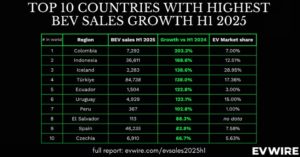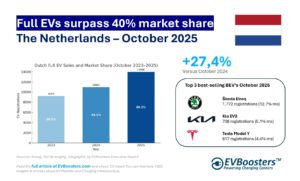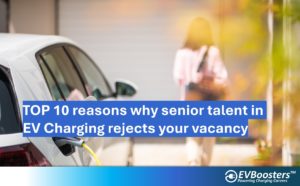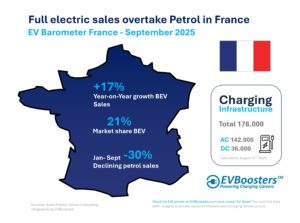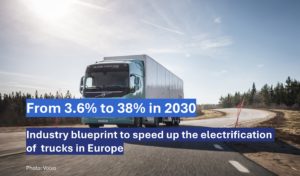Important driver; the Deutschlandnetz Initiative
One key driver behind this growth is the “Deutschlandnetz” initiative, which aims to close gaps in the charging network across the country. Under the Fast Charging Act (SchnellLG), this government-led project awards tenders for 900 regional sites and 200 motorway locations. These strategically distributed sites must meet high standards for usability, accessibility, and performance, including delivering a maximum power of at least 300 kilowatts.
The initiative plays a critical role in ensuring that no region in Germany is left behind in the EV transition, providing drivers with rapid and convenient access to charging infrastructure, even in remote areas.
Key Players in the German Fast-Charging Market
The German fast-charging market is driven by several key operators, each contributing to the growing infrastructure. Here’s how they performed in 2024:
1. EnBW (6005 chargers, +355 growth)
EnBW remains the market leader, expanding its network progressively with 355 new chargers in December 2024 alone. With the largest number of fast chargers in the country, EnBW’s comprehensive coverage across urban and rural areas ensures reliability for all EV drivers. Part of this immense growth is the opening of a huge charging hub at Eschborn with 40 High Power Chargers (HPC’s).
EnBW and Globus plan to install 800 fast charging stations at more than 60 retail locations in the near future. Their expansive network across highways, cities, and rural areas is unmatched.
2. Tesla (3110 chargers, +114 growth)
Tesla’s shift toward opening its Supercharger network to non-Tesla vehicles has made it a top contender. With 3110 chargers, Tesla continues to combine convenience and performance, appealing to a broad range of EV users.
3. Aral Pulse (2317 chargers, +124 growth)
Aral Pulse has strategically placed chargers at petrol stations, making it a convenient choice for drivers. Their strong growth reflects their ability to integrate charging solutions into existing infrastructure.
4. Allego (1541 chargers, +32 growth)
Allego focuses on urban areas and shopping centers, catering to city dwellers. Though their growth is modest, their presence in high-demand locations makes them an important player.
5. EWE Go (1531 chargers, +58 growth)
EWE Go’s focus on Northern Germany has allowed it to build a strong regional presence. Their steady growth demonstrates the importance of regional operators in Germany’s charging ecosystem.
6. Shell Recharge (1143 chargers, +46 growth)
Shell Recharge bridges the gap between traditional fuel stations and EV charging. Their focus on high-speed chargers at familiar locations is helping smooth the transition for EV adopters.
7. Pfalzwerke (1141 chargers, +59 growth)
Pfalzwerke’s strong presence in Southern Germany highlights the role of regional operators in expanding EV infrastructure. Their growth mirrors that of larger players, proving regional markets are vital to the overall network.
8. Ionity (1084 chargers, +64 growth)
Ionity’s high-power chargers are designed for long-distance travel, making them a premium choice for highway drivers. Their focus on fast, efficient charging ensures they remain a key player in the market.
Challenges and Success Factors for 2025
1. Impact of the AFIR Regulation
The Alternative Fuels Infrastructure Regulation (AFIR) has introduced new requirements that are reshaping the fast-charging landscape in Germany. This EU-wide directive mandates that all charging stations allow both open-loop and closed-loop payments, ensuring accessibility for all EV users. Additionally, it facilitates ad-hoc payments, making it easier for drivers to charge without subscriptions or specific apps.
While this increases convenience for users, it poses significant challenges for operators:
- Major Investments: CPOs must invest heavily in upgrading their systems to meet AFIR standards. This includes retrofitting existing chargers with contactless payment terminals and ensuring compatibility with multiple platforms.
- Operational Complexity: Ensuring interoperability across different systems requires advanced software and reliable data-sharing protocols.
- Cost Pressures: The additional costs of compliance could impact profitability, especially for smaller operators.
Despite these hurdles, AFIR is expected to enhance user experience and drive further EV adoption.
2. Electrical Grid Capacity
The strain on the electrical grid remains a pressing issue. While beneficial for users, Ultra-fast chargers require significant power, which many areas cannot currently supply. Solutions like bidirectional charging (vehicle-to-grid) and grid expansion will be critical for managing demand. However, legislative barriers, such as network fees, continue to impede progress.
3. Scalability and Data-Driven Optimization
CPOs must focus on scalability and efficiency. Access to network capacities and reliable site data is crucial. Operators can ensure long-term profitability and sustainability by using data analytics to optimise load distribution, reduce bottlenecks, and improve uptime.
Bright future for fast charging hubs across Germany
Germany’s fast-charging market is on track for exponential growth by 2025. Initiatives like the Deutschlandnetz, coupled with private sector competition, are ensuring nationwide coverage. However, grid capacity, AFIR compliance, and long-term sustainability require innovative solutions, investments, and solid government policy.
By overcoming these challenges, Germany will maintain its leadership position as one of the frontrunners in the electrification of mobility towards


